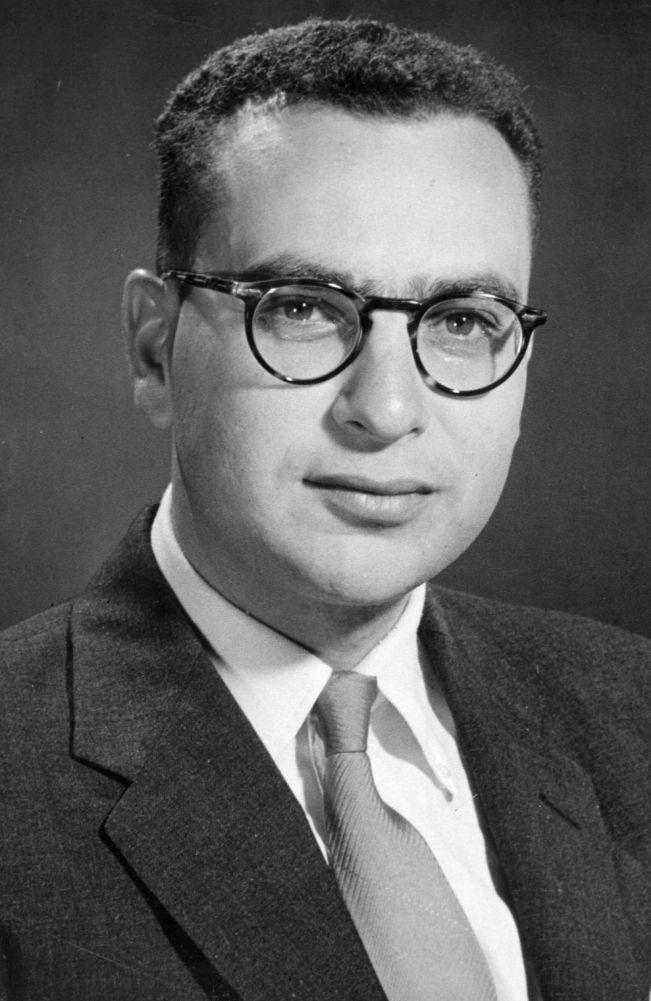Murray Gell-Mann
DOI: 10.1063/PT.3.4480
Murray Gell-Mann, the preeminent architect of theoretical elementary-particle physics, died on 24 May 2019 in Santa Fe, New Mexico. He received the 1969 Nobel Prize “for his contributions and discoveries concerning the classification of elementary particles and their interactions.” His contributions to physics include many foundational ideas, such as the renormalization group, which is fundamental to quantum field theory and statistical mechanics.

Murray Gell-Mann
HARVEY OF PASADENA/COURTESY AIP ESVA/PHYSICS TODAY COLLECTION

Gell-Mann was a child prodigy, born on 15 September 1929 into a Jewish Ukrainian immigrant family in Manhattan. He graduated valedictorian from the Columbia Grammar and Preparatory School at age 14, received a BS from Yale University in 1947, and earned a PhD from MIT in 1951 under adviser Victor Weisskopf.
In the early 1950s, Gell-Mann proposed a new quantum number, called strangeness, to explain the unusual properties of novel strongly interacting particles seen in cosmic rays. Strangeness proved to be a successful organizing principle of the vast spectrum of particles that subsequently emerged in accelerator experiments.
In 1961, to unify strangeness with nuclear isospin, Gell-Mann and, independently, Yuval Ne’eman, employed the unitary group SU(3). It led to the classification of particles by SU(3) multiplets, which Gell-Mann called the Eightfold Way (borrowing from the Noble Eightfold Path of Buddhism). That was pioneering work in the use of group theory to understand particle physics. The Eightfold Way made precise predictions for mesons and baryons, including new states, notably of the Ω− baryon, discovered at Brookhaven National Laboratory in 1964. A photograph of the bubble-chamber footprint of the Ω− hung for many years, slightly skewed by a California earthquake, above Gell-Mann’s blackboard at Caltech.
With the insight from SU(3) symmetry, in 1964 Gell-Mann proposed the concept of quarks as the underlying constituents of strongly interacting particles. (Independently, George Zweig developed it in a more phenomenological approach.) Gell-Mann was reticent about the reality of quarks because of the failure to produce them in the laboratory.
Earlier, in 1958, Gell-Mann, Richard Feynman, and others had realized that the weak β-decay interactions involve exclusively the left-handed “chirality” of particles. Gell-Mann played a major part in understanding the role of chirality and the masses of the spin-0 mesons by incorporating ideas of Yoichiro Nambu into the Gell-Mann–Levy Σ model (“current algebra” is a model-independent abstraction of those ideas). When small underlying quark masses are introduced into the Σ model, one gets precise predictions for the meson masses, known as the Gell-Mann–Okubo mass formula. Conversely, one can extract the light quark masses from the procedure.
Until 1970 no theory existed to explain how quarks were bound together to make baryons and mesons. A major insight came from James Bjorken, who predicted that the binding force would display “scaling behavior,” subsequently confirmed experimentally at SLAC. It implies that at very short distances, the quarks are effectively free particles. Gell-Mann, working at CERN in 1971 with William Bardeen, Harald Fritzsch, and Heinrich Leutwyler, considered a gauge theory of quark interactions, in which each quark comes in one of three varieties called “colors.” They wrote down the theory now known as quantum chromodynamics (QCD) and established the existence of the three quark colors from the rate of π0 decay.
In 1973 David Gross, David Politzer, and Frank Wilczek showed that QCD has the property of asymptotic freedom, which explains Bjorken scaling and the confinement of quarks into bound states of the baryons and mesons. The quarks thus became real particles, and together with leptons they form the basic building blocks of the standard model.
In 1954 Gell-Mann and Francis Low introduced into physics a remarkable concept now known as the renormalization group. Developed subsequently by Kenneth Wilson and others, it has proved to be of profound importance across many disciplines. The application of the renormalization group with the standard model has allowed us to contemplate physics at extremely short distances and opened the door to grand unification, modern inflationary cosmology, and superstring theory.
Gell-Mann was an early champion of string theory. He maintained a pioneering effort at Caltech in the 1970s and characterized himself as a kind of “zookeeper of endangered species.” John Schwarz, Joel Scherk, Pierre Ramond, Michael Green, and others established the defining principles of superstring theory. Gell-Mann’s work with Ramond and Richard Slansky is fundamental to present-day experiments seeking to disentangle the properties of the ubiquitous neutrinos.
Anyone encountering Murray had the feeling of being in the presence of a charming yet superhuman intellect. His far-ranging interests and activities—in physics, linguistics, ornithology, environmental policy, pre-Columbian archaeology, serving on the boards of the Smithsonian Institution and the MacArthur Foundation, establishing the Santa Fe Institute, and more—knew no bounds. Fred Zachariasen, Gell-Mann’s colleague, once remarked, “We physicists know and love Murray for quarks, but his work through the MacArthur Foundation to save the planet may ultimately have the greatest impact on everyone.”
More about the Authors
Christopher T. Hill. Fermi National Accelerator Laboratory, Batavia, Illinois.
